Energy Transfer and Destabilizing Impulse Inducing Mechanism of Coal–Rock System in Roadway through Coal Seam in Deep Zone
Abstract
1. Introduction
2. Appearance Characteristics of Rock Burst in the Main Roadway of a Deep Panel Area
3. Force and Energy Response Characteristics of Coal and Rock Systems with Different Stiffness Values
3.1. Test Method
- (1)
- Coal: 100 mm × 75 mm × 75 mm;
- (2)
- Sandstone–coal–Sandstone: Sandstone 30 mm × 75 mm × 75 mm, Coal 40 mm × 75 mm × 75 mm, Sandstone 30 mm × 75 mm × 75 mm;
- (3)
- Mudstone–coal–Mudstone: Mudstone 30 mm × 75 mm × 75 mm, Coal 40 mm × 75 mm × 75 mm, Mudstone 30 mm × 75 mm × 75 mm.
- (1)
- Initial stress loading stage: Three kinds of composite structures were each loaded to the initial stress environment with σ1 = 10 MPa, σ2 = 6 MPa, σ3 = 5 MPa, and loading rate = 0.05 MPa/s.
- (2)
- Pressure maintaining stage: With the three-way stress bearing of the specimen unchanged by means of force control, loading was performed for 120 s under pressure maintaining conditions, so as to reach the initial stress environment conforming to the field situation.
- (3)
- Minimum principal stress unloading stage: Instantaneous unloading was conducted at one side of the minimum principal stress σ3 to simulate the real situation in the case of sudden stress unloading at the side of the roadway excavation, and the maximum principal stress σ1 and intermediate principal stress σ2 were continuously kept constant by means of force control for 45 s.
- (4)
- Axial compression stage: The intermediate principal stress σ2 was unchanged, and the maximum principal stress σ1 was increased at a loading rate of 0.5 MPa/s until specimen failure.
3.2. Test Phenomena
- (1)
- Failure strength: sandstone–coal–sandstone combination > mudstone–coal–mudstone combination > pure coal;
- (2)
- Strain at peak point: pure coal > mudstone–coal–mudstone combination > sandstone–coal–sandstone combination;
- (3)
- Energy at peak point: sandstone–coal–sandstone combination > mudstone–coal–mudstone combination > pure coal;
- (4)
- Incubation time of failure: sandstone–coal–sandstone combination > mudstone–coal–mudstone combination > pure coal;
- (5)
- Dynamic failure time after peak: sandstone–coal–sandstone combination > mudstone–coal–mudstone combination > pure coal.
4. Evolution Law of Stress–Energy Field of Different Coal and Rock Systems
4.1. Establishment of Numerical Model
4.2. Evolution Law of Force and Energy in Loading Process
4.3. Discussion on the Relationship between Force and Energy of Different Coal and Rock Systems
5. Fractal Characteristics of Coal–Rock Samples
5.1. Fractal Dimension Fundamentals
5.2. Fractal Characteristics of Coal–Rock
6. Failure Mechanism Analysis of Coal and Rock System in the Main Roadway in the Panel Area
7. Prevention and Control Measures of Energy Release and Impact Prevention in Coal and Rock Systems of the Main Roadway in the Panel Area
7.1. Technical Measures for Energy Release and Impact Reduction
7.2. Application and Verification of Impact Reduction Measures
8. Conclusions
Author Contributions
Funding
Data Availability Statement
Acknowledgments
Conflicts of Interest
References
- Yuan, L. Research progress of mining response and disaster prevention and control in deep coal mines. J. China Coal Soc. 2021, 46, 716–725. [Google Scholar]
- Prochazka, P.P. Application of discrete element methods to fracture mechanic of rock burst. Eng. Fract. Mech. 2004, 71, 601–618. [Google Scholar] [CrossRef]
- Zhou, R.Z. Analysis of the occurrence law of rock burst and the mechanical mechanism of fracture. Chin. J. Geotech. Eng. 1995, 17, 111–117. [Google Scholar]
- Huang, Q.X.; Gao, Z.N. Mechanical model of damage fracture of roadway impact ground pressure. J. China Coal Soc. 2001, 26, 156–159. [Google Scholar]
- Manoj, N.B.; Petros, V. Fatigue and dynamic energy behaviour of rock subjected to cyclical loading. Int. J. Rock Mech. Min. Sci. 2009, 46, 200–209. [Google Scholar]
- Gao, M.S.; Dou, L.M.; Zhang, N.; Wang, K.Z.; Heng, B.S. Strength and weakness mechanical model and application analysis of surrounding rock control of impact ore pressure roadway. Rock Soil Mech. 2008, 29, 359–364. [Google Scholar]
- Liu, X.H.; Xue, Y.; Zheng, J.; Gui, X. Research on energy release in coal rock fragmentation process under impact load. Chin. J. Rock Mech. Eng. 2021, 40 (Suppl. S2), 3201–3211. [Google Scholar]
- Zhao, T.B.; Yin, Y.C.; Tan, Y.L. Development of a rock testing system with changeable stiffness and its application in the study on the rock failure mechanical behavior. Chin. J. Rock Mech. Eng. 2022, 41, 1846–1857. [Google Scholar]
- Zuo, J.P.; Chen, Y.; Cui, F. Differences in mechanical properties and impact tendency analysis of different coal-rock assemblages. J. China Univ. Min. Technol. 2018, 47, 81–87. [Google Scholar]
- Tan, Y.L.; Guo, W.Y.; Xin, H.Q.; Zhao, T.B.; Yu, F.H.; Liu, X.S. Research on key technology of impact pressure monitoring and risk solving in deep mining of coal mine. J. China Coal Soc. 2019, 44, 160–172. [Google Scholar]
- Eberhardt, S.S. Quantifying progressive pre-peak brittle fracture damage in rock during uniaxial compression. Int. J. Rock Mech. Min. Sci. 1999, 36, 361–380. [Google Scholar] [CrossRef]
- Liu, S.H. Mutation model and chaotic mechanism of failure instability of combined coal rock under dynamic and static loading. J. China Coal Soc. 2014, 39, 292–300. [Google Scholar]
- Liu, B.; Yang, R.S.; Guo, D.M.; Zhang, D.Z. Combined experimental study on impact tendency of deep coal rock at the level of Suncun coal mine. Chin. J. Rock Mech. Eng. 2004, 23, 2402–2408. [Google Scholar]
- Tutuncu, A.N.; Podio, A.L.; Grogory, A.R.; Sharma, M.M. Nonlinear viscoelastic behavior of sedimentary rocks. Part1: Effect of frequency and strain amplitude. Lead. Edge 1998, 63, 184–194. [Google Scholar]
- Zhao, X.Y.; Jiang, Y.D.; Zhu, J.; Sun, G.Z. Experimental Research on Precursor Information of Deformation and Failure of Coal-rock Combination. Chin. J. Rock Mech. Eng. 2008, 27, 339–346. [Google Scholar]
- Zhao, S.K.; Zhang, Y.; Han, R.J.; Jiang, H.B.; Zhang, N.B.; Xu, Z.J. Numerical simulation of impact tendency evolution of combined coal rock structure. J. Liaoning Tech. Univ. 2013, 32, 1441–1446. [Google Scholar]
- Liu, J.; Wang, E.Y.; Song, D.Z.; Yang, S.L.; Niu, Y. Effect of rock strength on mechanical behavior and acoustic emission characteristics of combined specimens. J. China Coal Soc. 2014, 39, 685–691. [Google Scholar]
- Lippmann, H. Mechanics of “bumps” in coal mines: A discussion of violent deformation in the sides of roadways in coal seams. Appl. Mech. Rev. 1987, 40, 1033–1043. [Google Scholar] [CrossRef]
- He, M.C.; Sousa, L.R.E.; Miranda, T.; Zhu, G.L. Rock burst laboratory tests database Application of data mining techniques. Eng. Geol. 2015, 185, 116–130. [Google Scholar] [CrossRef]
- Du, L.M.; Mou, Z.L.; Cao, A.Y.; Gong, S.Y.; He, H.; Lu, C.P. Prevention and Control of Coal Mine Impact Mine Pressure; Science Press: Beijing, China, 2017. [Google Scholar]
- Lau, J.S.O.; Chandler, N.A. Innovative laboratory testing. Int. J. Rock Mech. Min. Sci. 2004, 41, 1427–1445. [Google Scholar] [CrossRef]
- Fuenkajorn, K.; Sriapai, T.; Samsri, P. Effects of loading rate on strength and deformability of MahaSarakham salt. Eng. Geol. 2012, 135–136, 10–23. [Google Scholar] [CrossRef]
- Ghamgosar, M.; Bahaaddini, M.; Erarslan, N.; Williams, D.J. A new experimental approach to quantify microfractures in the Fracture Process Zone (FPZ) under various loading conditions. Eng. Geol. 2021, 283, 106024. [Google Scholar] [CrossRef]
- Nezhad, M.M.; Fisher, Q.; Gironacci, E.; Rezania, M. Experimental study and numerical modeling of fracture propagation in shale rocks during Brazilian disc test. Rock Mech. Rock Eng. 2018, 51, 1755–1775. [Google Scholar] [CrossRef]
- Zhang, Z.Z.; Gao, F. Experimental study on energy evolution characteristics of three rocks. J. China Univ. Min. Technol. 2015, 44, 416–422. [Google Scholar]
- Zhang, Z.Z.; Gao, F. Experimental investigation on the energy evolution of dry and water saturated red sandstones. Int. J. Min. Sci. Technol. 2015, 25, 383–388. [Google Scholar] [CrossRef]
- Niu, S.J.; Ge, S.S.; Yang, D.F.; Dang, Y.-H.; Yu, J.; Zhang, S. Mechanical properties and energy mechanism of saturated sandstones. J. Cent. South Univ. 2018, 25, 1447–1463. [Google Scholar] [CrossRef]
- Mandelbrot, B.B. Fractals: Form, Chance and Dimension; W. H. Freeman: San Francisco, CA, USA, 1977. [Google Scholar]
- Cannon, J.W. The Fractal Geometry of Nature. By Benoit, B. Mandelbrot. Am. Math. Mon. 1984, 91, 594–598. [Google Scholar] [CrossRef]
- Tyler, S.W.; Wheat-craft, S.W. Fractal Scaling of Soil Particle-size Distributions: Analysis and Limitations. Soil Sci. Soc. Am. J. 1992, 56, 362–369. [Google Scholar] [CrossRef]
- Katz, A.J.; Thompason, A.H. Fractal sandstone Pores: Implications for conductivity and pore formation. Phys. Rev. Lett. 1985, 54, 1325–1328. [Google Scholar] [CrossRef]
- Falconer, K.J. Fractal Geometry: Mathematical Foundations and Applications; Wiley: Bristol, UK, 1989. [Google Scholar]
- Li, J.Z.; Xie, G.X.; Wang, L.; Li, Y. Mechanical mechanism of dynamic fracture evolution of coal floor unloading in deep mining. J. Min. Saf. Eng. 2017, 34, 876–883. [Google Scholar]
- Xie, H. Research review of the state key research development program ofChina:Deep rock mechanics and mining theory. J. China Coal Soc. 2019, 44, 1283–1305. [Google Scholar]
- Yu, H.; Li, X.J.; Li, B.Y. Macro-micro mechanical response and energy mechanism of surrounding rock under excavation disturbance. J. China Coal Soc. 2020, 45, 60–69. [Google Scholar]
- Qi, Q.X.; Li, H.T.; Zheng, W.J. Physical model and measurement method forcelastic deformation energy characterization of coal and rock. Coal Sci. Technol. 2022, 50, 70–77. [Google Scholar]
- Ang, L.; Gao, F.Q.; Wang, X.Q. Energy evolution law and failure mechanism of coal-rock combined specimen. J. China Coal Soc. 2019, 44, 3894–3902. [Google Scholar]
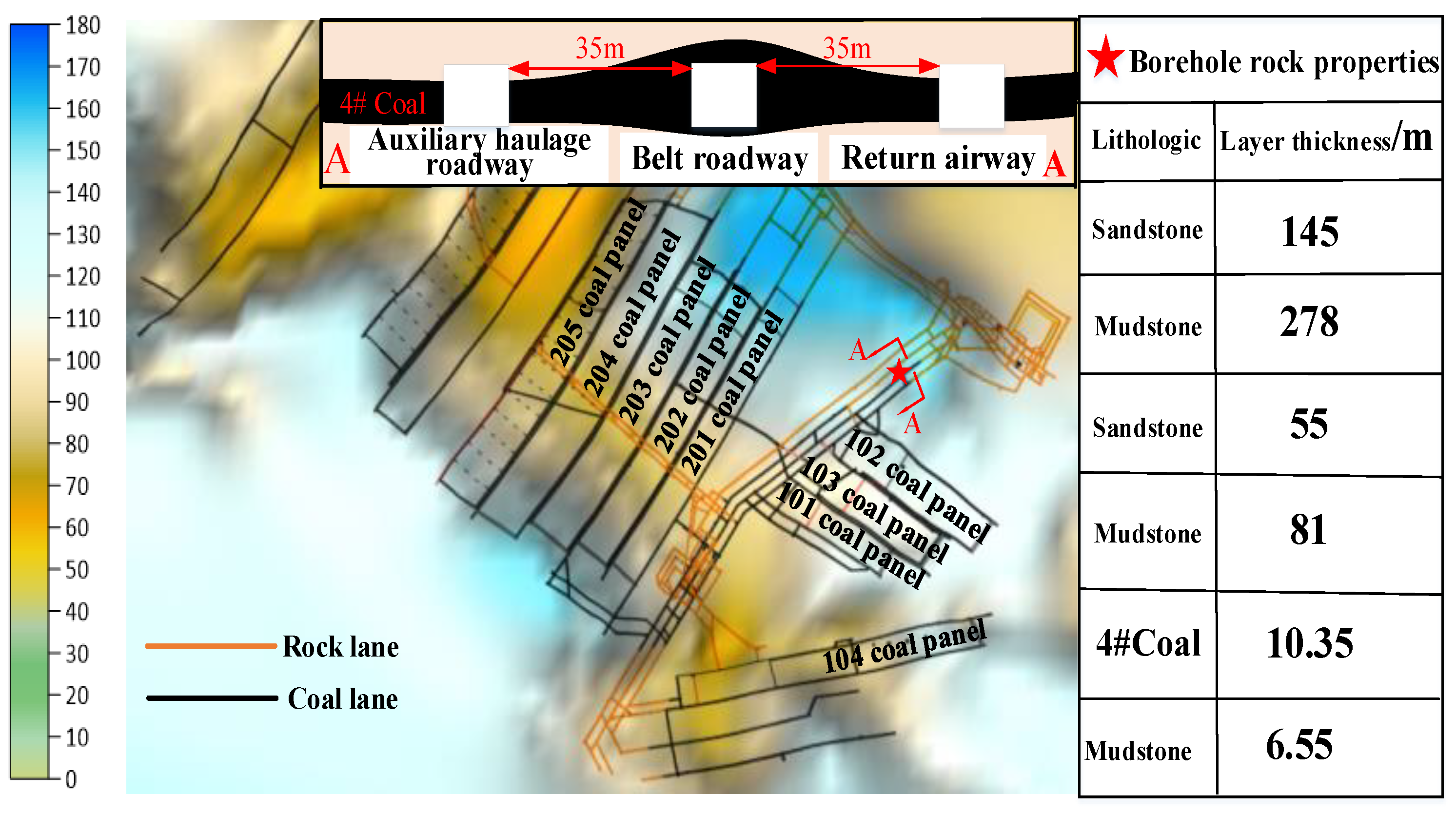

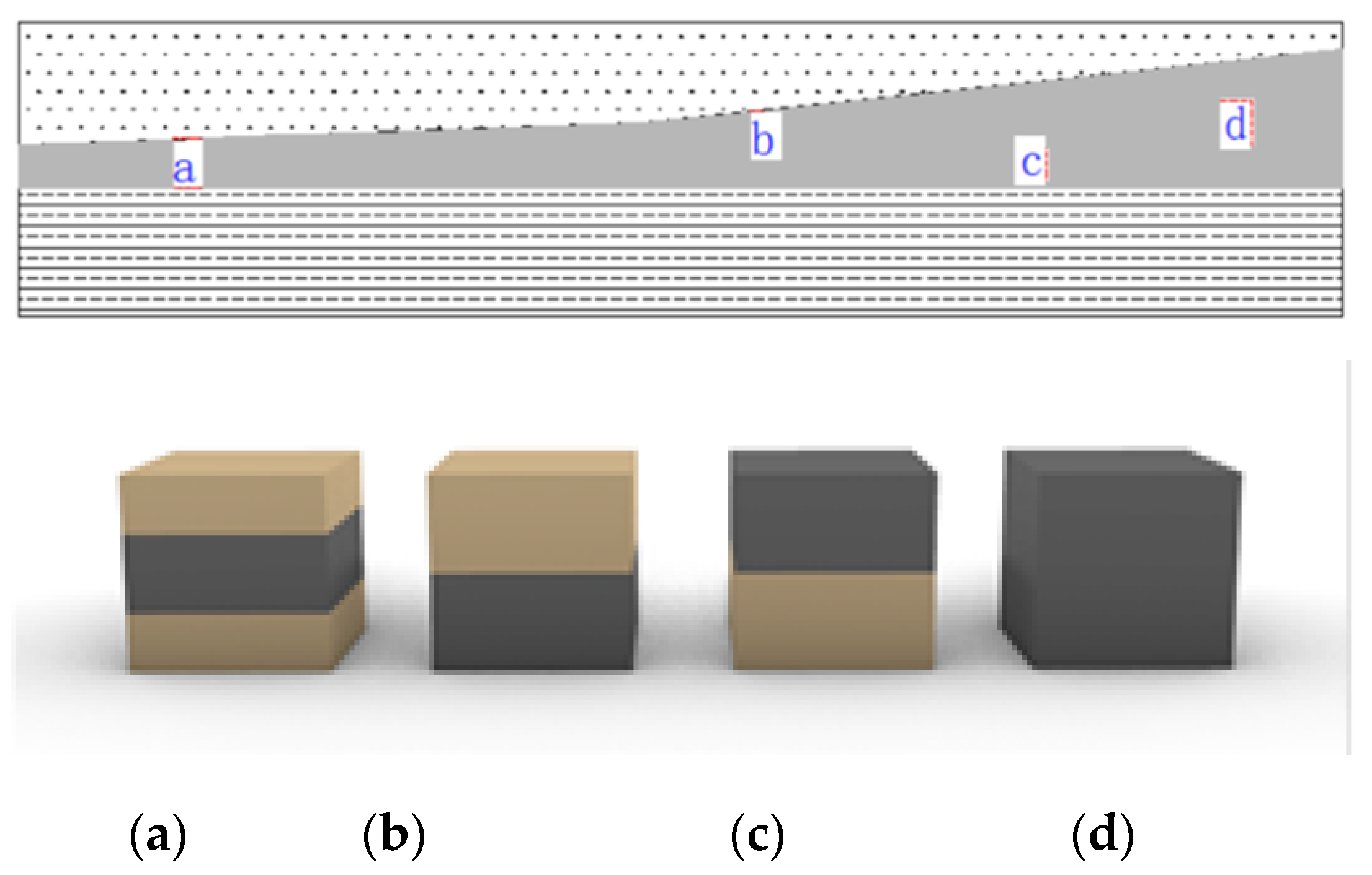
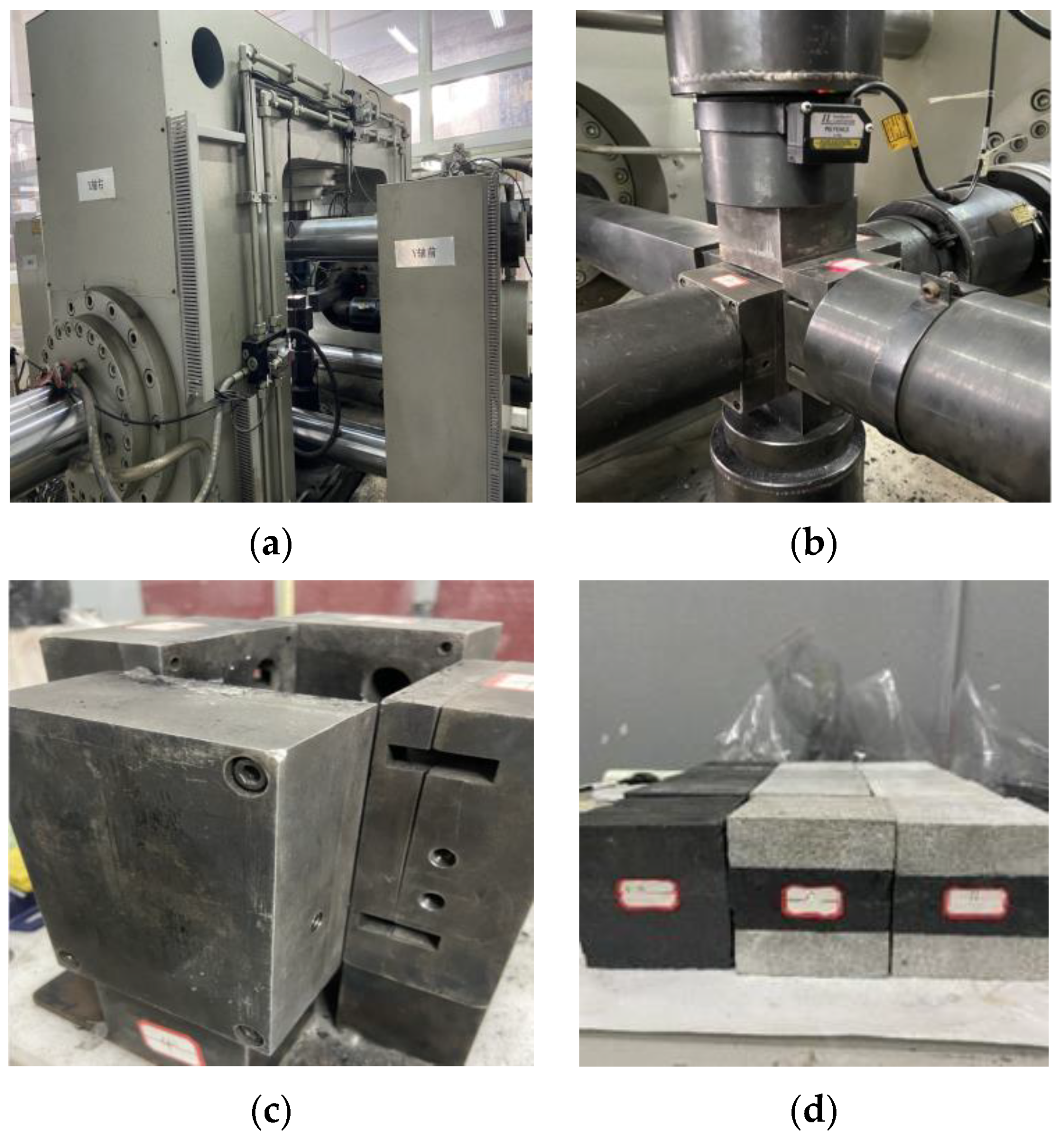
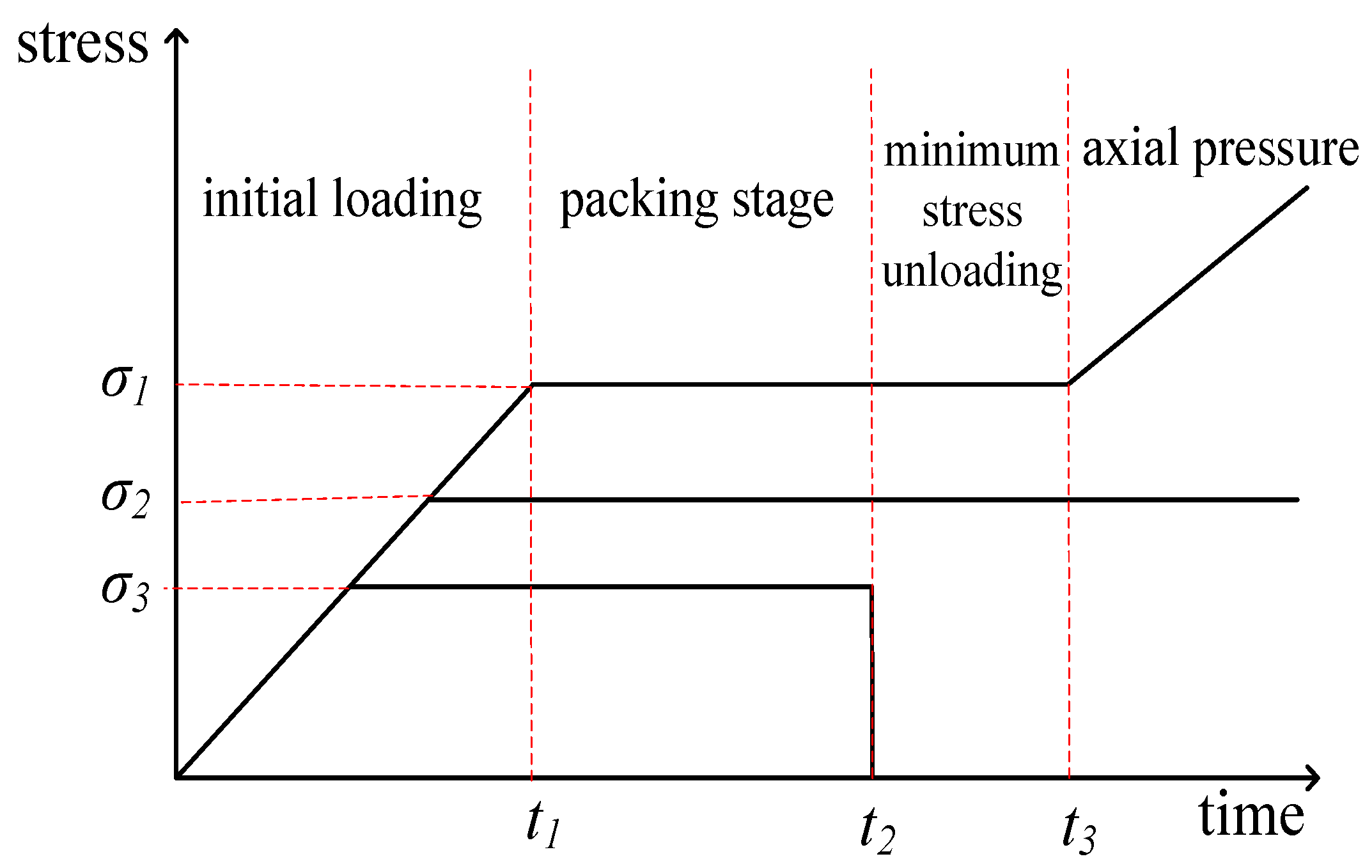
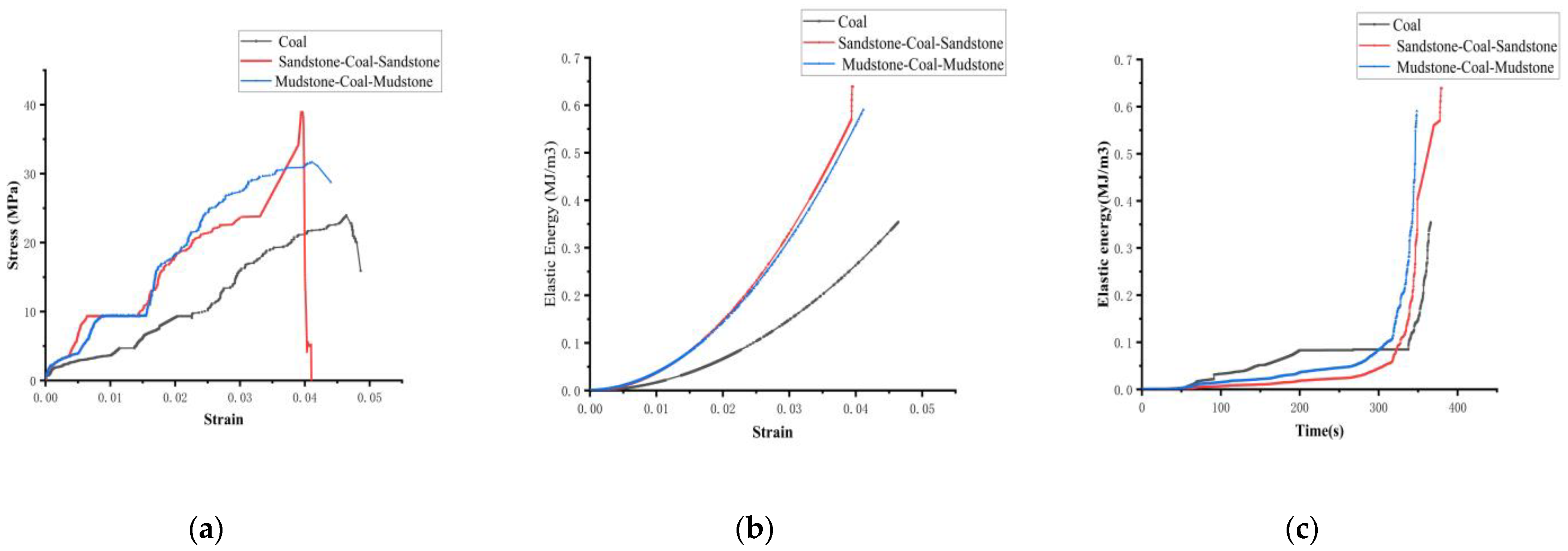

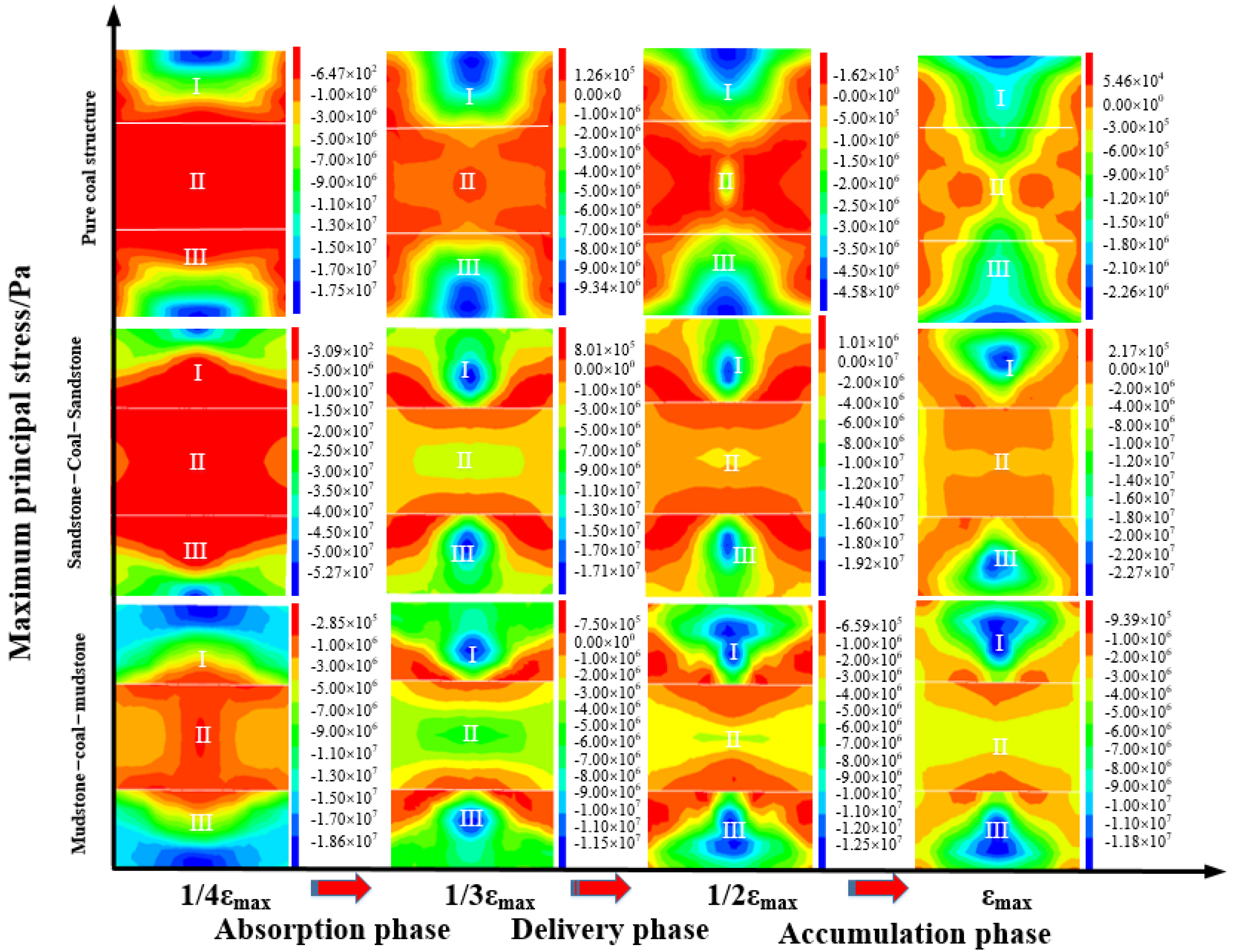
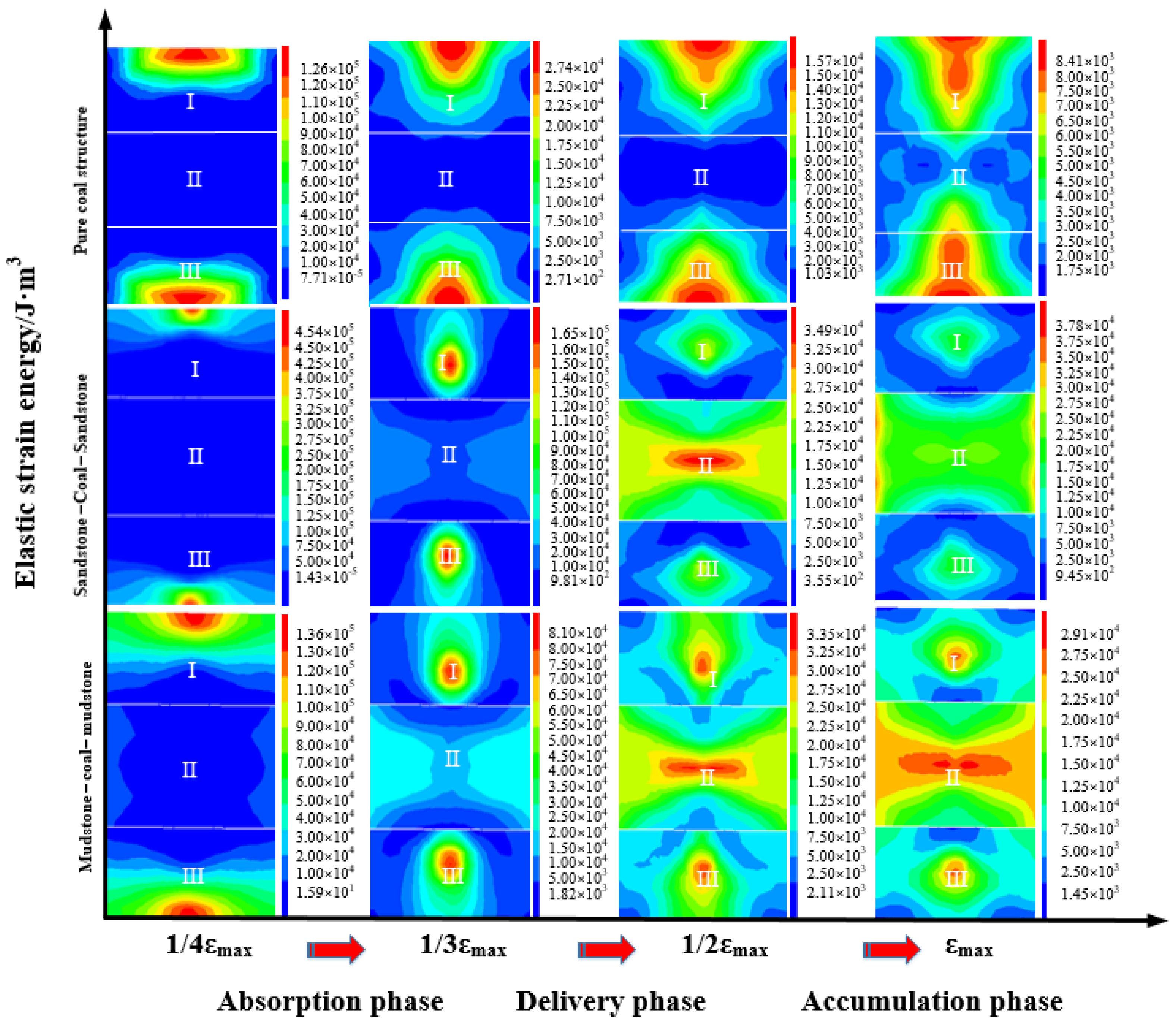
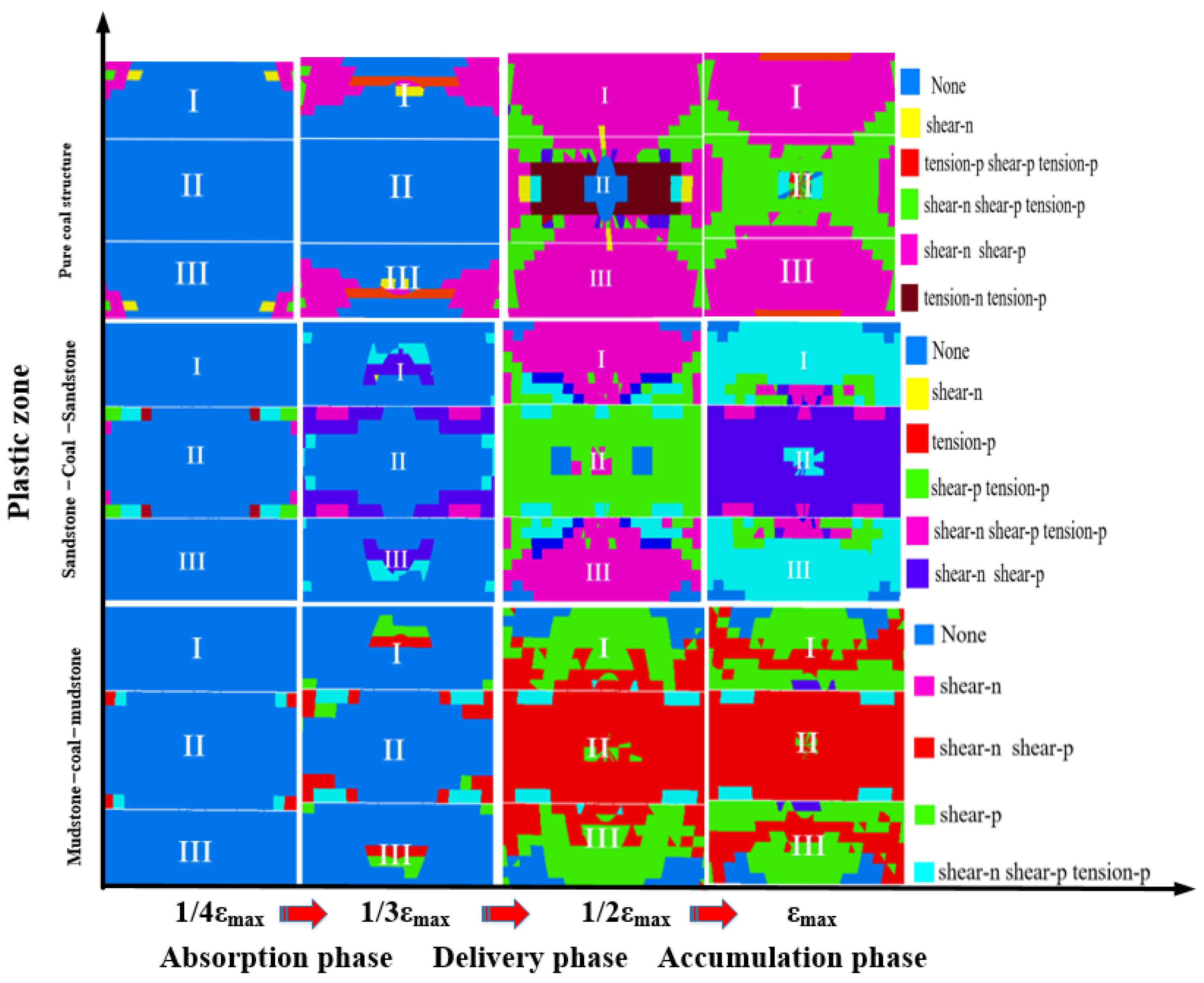
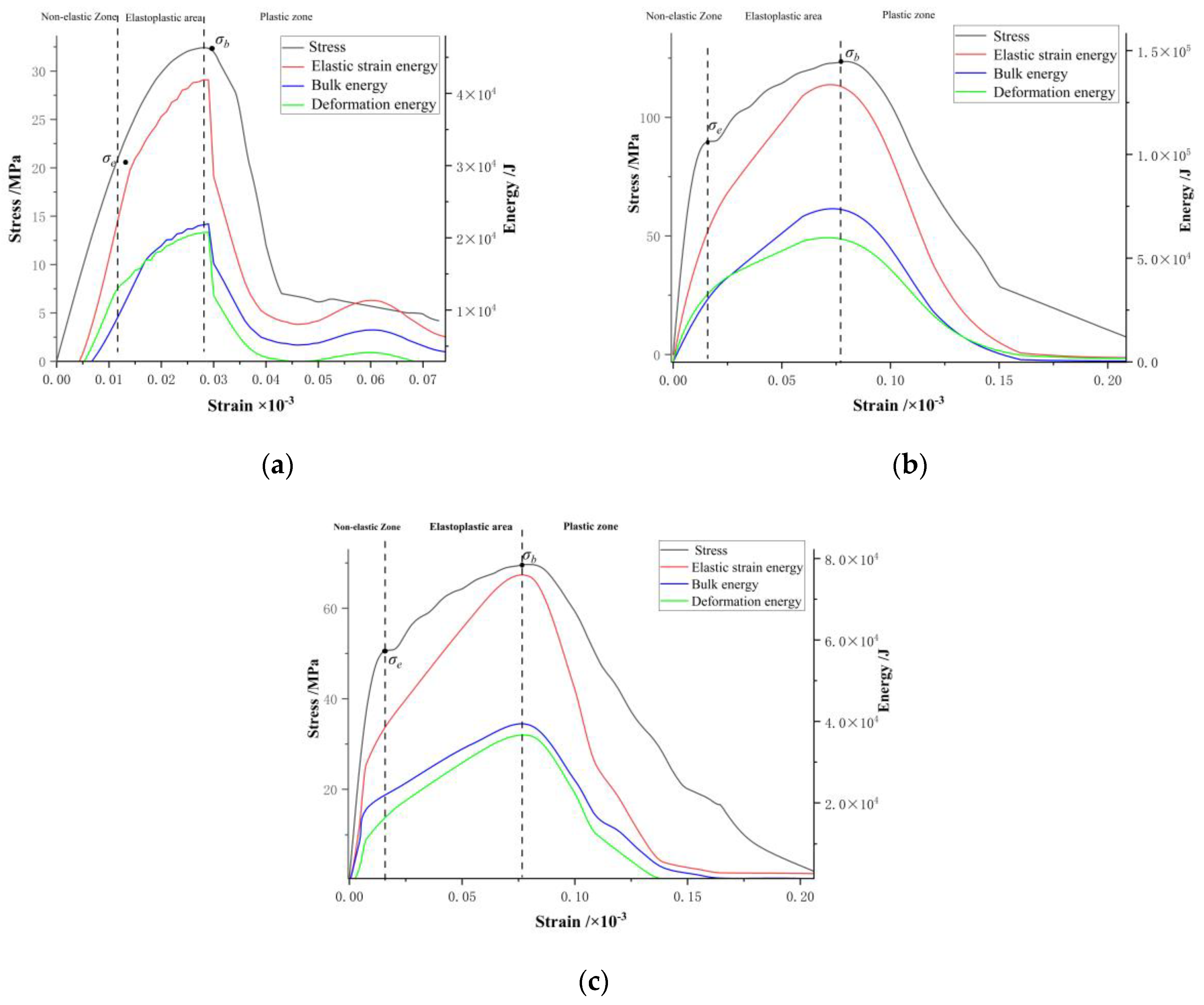

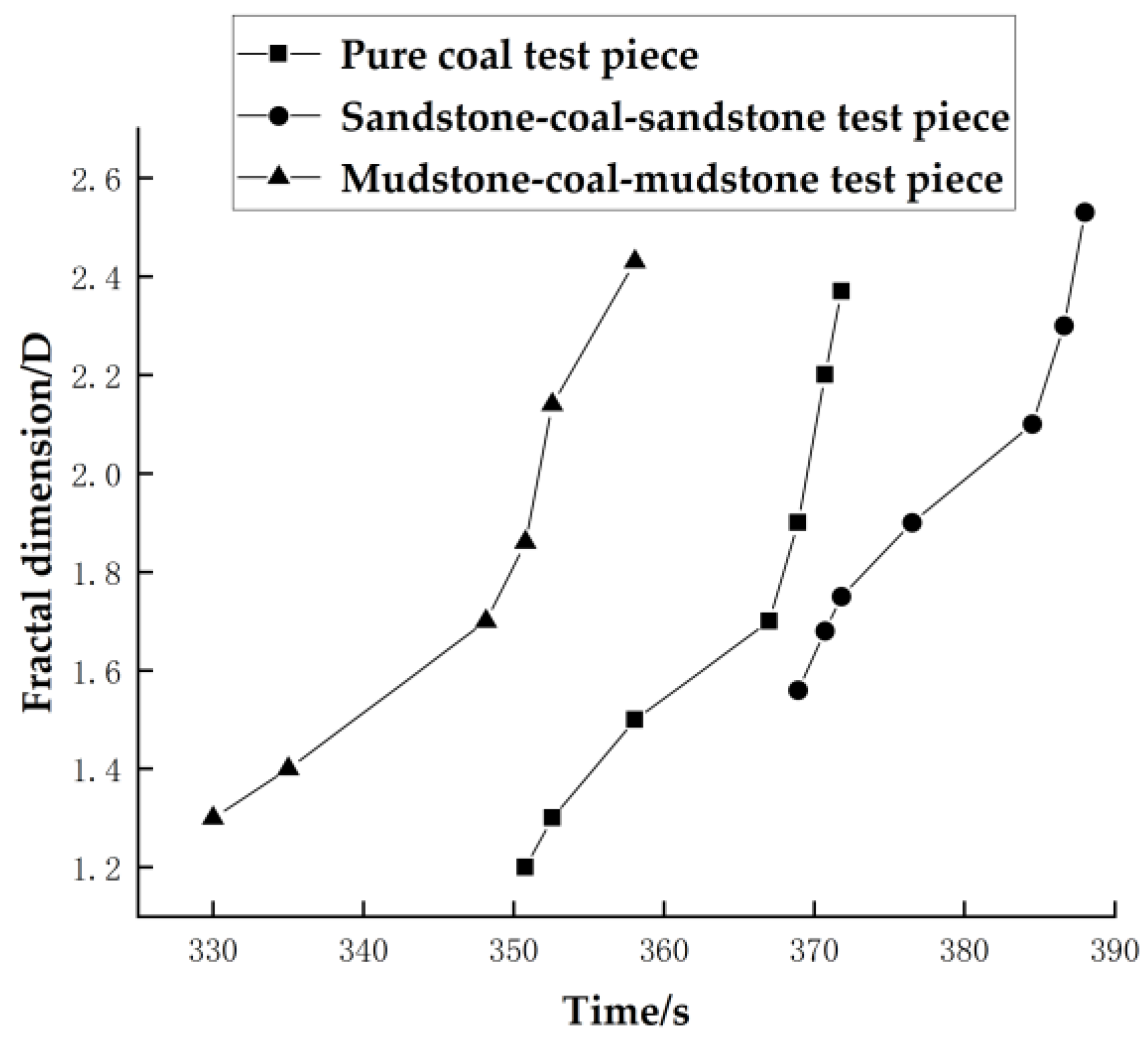


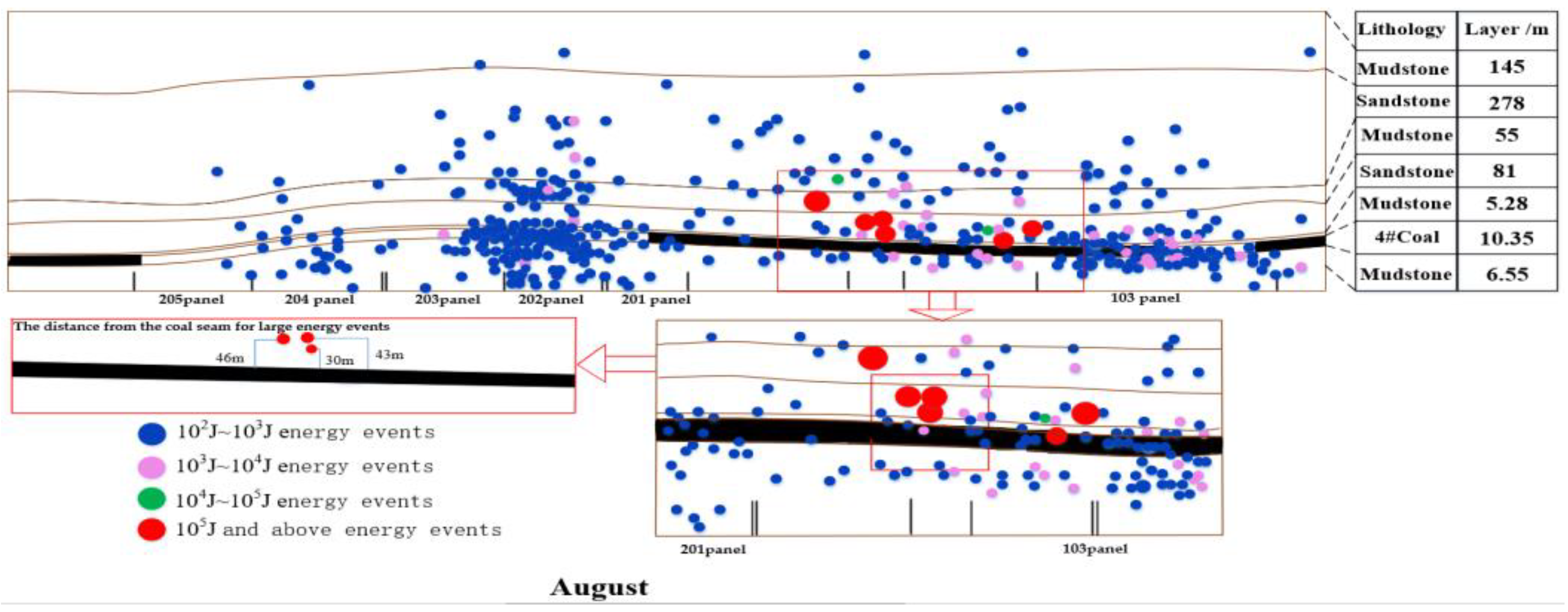

| Number | Monitor Energy/KJ | Frequency/Hz | Maximum Particle Peak Vibration Rate/m/s | Strain Rate/×10−3 s−1 |
|---|---|---|---|---|
| 1 | 0.296 | 5~30 | 0.13~0.4 | 1.65~3.0 |
| 2 | 0.4 | 5~30 | 0.18~0.66 | 2.3~50 |
| 3 | 0.895 | 3~28 | 0.20~0.65 | 1.5~46 |
| 4 | 1.24 | 3~25 | 0.20~0.84 | 1.5~53 |
| 5 | 8.27 | 2~18 | 0.34~1.00 | 1.7~46 |
| 6 | 22.6 | 2~18 | 0.79~3.44 | 4.0~160 |
| 7 | 27.1 | 1~15 | 0.44~3.50 | 11~130 |
| 8 | 50.4 | 2.5~15 | 0.50~3.27 | 3.2~120 |
| 9 | 103 | 0.5~12 | 1.23~3.65 | 1.6~110 |
| 10 | 3970 | 0.4~5 | 8.45~12.27 | 8.6~160 |
| Specimen No. | Failure Strength /MPa | Strain at Peak Point | Energy at Peak Point /MJ·m3 | Incubation Time of Failure/s | Post-Peak Dynamic Failure Time/s |
|---|---|---|---|---|---|
| Coal | 23.96 | 0.046 | 0.53 | 28 | 4.50 |
| Sandstone–coal–Sandstone | 38.93 | 0.039 | 0.76 | 58.5 | 11.50 |
| Mudstone–coal–Mudstone | 31.66 | 0.041 | 0.73 | 44.39 | 9.91 |
| Lithology | Bulk Modulus/GPa | Shear Modulus/GPa | Density /kg·m−3 | Cohesion/Mpa | Internal Friction Angle/° | Tensile Strength/GPa |
|---|---|---|---|---|---|---|
| Sandstone | 12 | 8 | 2700 | 2.00 | 45 | 0.2 |
| Coal | 4.9 | 2.01 | 1380 | 1.25 | 32 | 0.15 |
| Mudstone | 2.56 | 2.36 | 2530 | 2.16 | 36 | 0.75 |
| Coal and Rock System | Absorption Stage | Accumulation Stage | Release Stage | |||
|---|---|---|---|---|---|---|
| Maximum Principal Stress/MPa | Elastic Strain Energy/J·m3 | Maximum Principal Stress/MPa | Elastic Strain Energy/J·m3 | Maximum Principal Stress/MPa | Elastic Strain Energy/J·m3 | |
| Coal system | 1.5 | 2.71 × 102 | 3 | 2 × 103 | 0.6 | 1.75 × 103 |
| Sandstone–coal–Sandstone system | 3 | 9.81 × 102 | 6 | 3.49 × 104 | 2 | 2 × 104 |
| Mudstone–coal–Mudstone system | 5 | 2 × 104 | 7 | 3.35 × 104 | 2 | 2.91 × 104 |
| Coal and Rock System | Strain | Strength/MPa | Elastic Strain Energy/J | Proportion of Elastic Strain Energy Accumulated | Proportion of Elastic Strain Energy Released |
|---|---|---|---|---|---|
| Coal system | 0.011 × 10−3 | 19.96 | 2.34 × 104 | 79.06% | 85.27% |
| 0.028 × 10−3 | 32.42 | 4.19 × 104 | |||
| 0.075 × 10−3 | 3.90 | 6.17 × 103 | |||
| Sandstone–coal–sandstone system | 0.015 × 10−3 | 89.04 | 6.74 × 104 | 118.10% | 98.69% |
| 0.08 × 10−3 | 123.52 | 1.47 × 105 | |||
| 0.17 × 10−3 | 21.66 | 2.00 × 103 | |||
| Mudstone–coal–mudstone system | 0.014 × 10−3 | 50.11 | 4.05 × 104 | 84.45% | 95.26% |
| Coal and Rock System | Pre-Peak Linear Equation | Pre-Peak Intercept | Pre-Peak Slope | Post-Peak Linear Equation | Post-Peak Intercept | Post-Peak Slope |
|---|---|---|---|---|---|---|
| Coal system | y1 = 1158.56x1 + 5.07 | 5.07 ± 0.99 | 1158.56 ± 59.79 | y1′ = −18.46x1 + 12.65 | 12.65 ± 0.05 | −18.46 ± 0.22 |
| Sandstone–coal–Sandstone system | y2 = 930.17x2 + 63.87 | 63.87 ± 2.07 | 930.17 ± 45.02 | y2′ = 760.15x2 + 61.23 | 61.23 ± 1.51 | −760.15 ± 122.72 |
| Mudstone–coal–Mudstone system | y3 = 528.99x3 + 35.82 | 35.82 ± 1.17 | 528.99 ± 35.83 | y3′ = 450.51x3 + 35.52 | 35.52 ± 0.74 | −450.51 ± 11.40 |
| Energy Range | Date | ||
|---|---|---|---|
| 10.1~10.31 | 11.1~11.30 | 12.1~12.31 | |
| 102~103 J | 648 | 125 | 101 |
| 103~104 J | 164 | 177 | 19 |
| 104~105 J | 2 | 3 | 1 |
| Above 105 J | 7 | 7 | 1 |
Disclaimer/Publisher’s Note: The statements, opinions and data contained in all publications are solely those of the individual author(s) and contributor(s) and not of MDPI and/or the editor(s). MDPI and/or the editor(s) disclaim responsibility for any injury to people or property resulting from any ideas, methods, instructions or products referred to in the content. |
© 2023 by the authors. Licensee MDPI, Basel, Switzerland. This article is an open access article distributed under the terms and conditions of the Creative Commons Attribution (CC BY) license (https://creativecommons.org/licenses/by/4.0/).
Share and Cite
Li, J.; Zhou, W.; Chu, J.; Ren, W.; Dou, L.; Song, S. Energy Transfer and Destabilizing Impulse Inducing Mechanism of Coal–Rock System in Roadway through Coal Seam in Deep Zone. Fractal Fract. 2023, 7, 550. https://doi.org/10.3390/fractalfract7070550
Li J, Zhou W, Chu J, Ren W, Dou L, Song S. Energy Transfer and Destabilizing Impulse Inducing Mechanism of Coal–Rock System in Roadway through Coal Seam in Deep Zone. Fractal and Fractional. 2023; 7(7):550. https://doi.org/10.3390/fractalfract7070550
Chicago/Turabian StyleLi, Jiazhuo, Wei Zhou, Jiaqi Chu, Wentao Ren, Linming Dou, and Shikang Song. 2023. "Energy Transfer and Destabilizing Impulse Inducing Mechanism of Coal–Rock System in Roadway through Coal Seam in Deep Zone" Fractal and Fractional 7, no. 7: 550. https://doi.org/10.3390/fractalfract7070550
APA StyleLi, J., Zhou, W., Chu, J., Ren, W., Dou, L., & Song, S. (2023). Energy Transfer and Destabilizing Impulse Inducing Mechanism of Coal–Rock System in Roadway through Coal Seam in Deep Zone. Fractal and Fractional, 7(7), 550. https://doi.org/10.3390/fractalfract7070550





